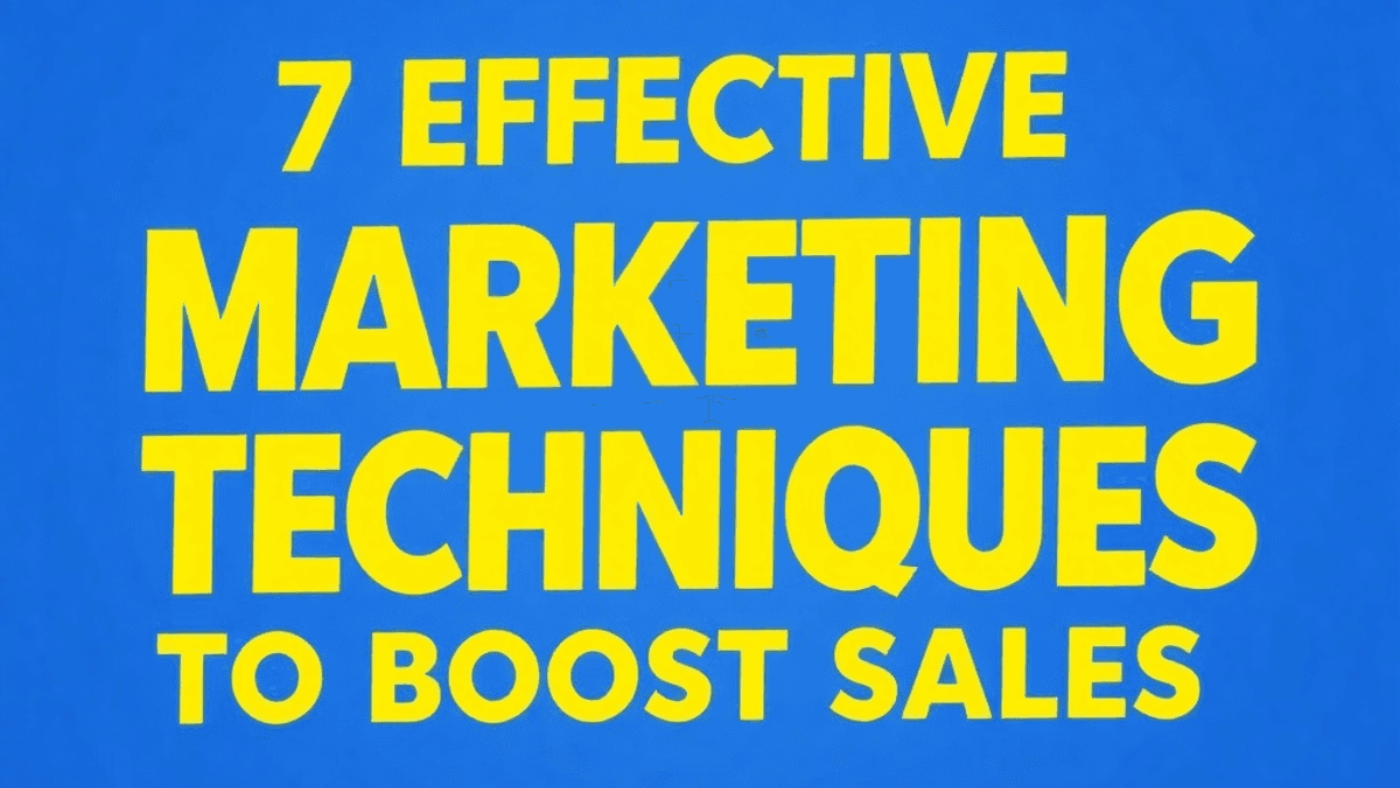
7 Effective Dropshipping Marketing Techniques to Boost Sales

The world of dropshipping offers a unique business model where you can sell products without holding inventory. Yet, this convenience comes with its own set of challenges. The market’s saturation means that standing out amidst fierce competition and gaining visibility is crucial. Without effective marketing strategies, even the most innovative dropshipping business can struggle to thrive.
Effective dropshipping marketing techniques are essential in driving sales and ensuring your store reaches potential customers. With countless stores vying for attention, implementing the right marketing moves can be the difference between obscurity and success.
This article aims to equip you with 7 proven marketing techniques specifically tailored for dropshipping businesses. By exploring these strategies, you’ll learn how to effectively promote your dropshipping products and carve a unique space in the competitive landscape. Whether you’re new to the industry or looking to optimize your current approach, these insights will help you attract more customers and boost your sales performance.
To further enhance your understanding of the dropshipping model, it’s worth comparing it with other business models like network marketing. For a comprehensive analysis, check out this insightful piece on dropshipping vs network marketing.
In this article, we will explore each strategy in detail, providing practical tips and examples that can take your dropshipping efforts to new heights. Remember, implementing these strategies could significantly increase your sales, much like the 23 useful strategies outlined in another article which could serve as a great supplement to this guide.
1. Use Social Media to Your Advantage
Social media platforms are essential tools for increasing brand visibility and directing traffic to your dropshipping store. A well-designed social media strategy for dropshipping can help your business stand out in a competitive market.
TikTok Marketing
TikTok Marketing offers a unique opportunity to tap into viral trends. By creating engaging videos, you can showcase your products in an entertaining way. Consider the following tips:
- Align with trending hashtags and challenges to increase visibility.
- Use captivating visuals and soundtracks that resonate with your target audience.
- Encourage user-generated content by hosting contests or challenges related to your products.
Instagram Advertising
On the other hand, Instagram Advertising is a powerful method to reach a broader audience. Instagram ads allow for precise targeting based on demographics, interests, and behaviors. Key strategies include:
- Utilizing carousel ads to display multiple products or tell a story about your brand.
- Collaborating with popular meme pages or influencers to integrate your products seamlessly into entertaining content.
- Leveraging Instagram Stories ads for time-sensitive promotions or limited-time offers.
By combining these two platforms, you can significantly increase your visibility and drive conversions by reaching potential customers where they spend most of their time online.
2. Optimize Your Store for Search Engines
Importance of SEO in Dropshipping
In the competitive world of dropshipping, Search Engine Optimization (SEO) is a must-have tool for gaining long-term visibility. When done right, SEO improves your store’s presence on search engine results pages, bringing in organic traffic without the ongoing costs of paid advertising. By boosting your search rankings, you make sure that potential customers can find your products when they search for relevant terms.
Conducting Keyword Research
To find profitable niches and optimize product listings, keyword research is crucial. Here’s how to do it:
- Identify Your Niche: Start by defining the specific market segment you want to target. Understanding your niche will help narrow down relevant keywords.
- Use Keyword Research Tools: Use tools like Google’s Keyword Planner, Ahrefs, or SEMrush to generate a list of potential keywords related to your niche. These tools provide insights into search volume and competition levels.
- Analyze Competitors: Look at what keywords your competitors are targeting. This can give you ideas on gaps you might fill or strategies to set your offerings apart.
- Select Long-Tail Keywords: Focus on long-tail keywords as they often have lower competition and attract more targeted traffic. For example, instead of “running shoes,” go for “lightweight running shoes for women.”
- Optimize Product Listings: Naturally include the chosen keywords into product titles, descriptions, and metadata. This practice enhances both user experience and search engine understanding.
By mastering these techniques, you position your dropshipping business for sustainable growth through improved online visibility and customer reach. Additionally, using platforms like Anstrex can greatly simplify the process of finding hot selling dropship products and managing your store from one single platform, further boosting your SEO efforts and overall business success.
3. Build Strong Relationships with Your Customers Through Email Marketing
Effective email marketing for eCommerce businesses is a cornerstone of customer retention strategies and dropshipping marketing techniques. Creating personalized email campaigns is essential to resonate with your target audience and drive repeat purchases. Tailor your messages based on customer behavior, preferences, and past interactions to enhance relevance and engagement.
1. Segment Your Audience
Divide your email list into distinct groups based on demographics, purchase history, or browsing behavior. This allows you to send targeted messages that speak directly to each segment’s interests.
2. Personalize Your Emails
Use customer names in subject lines and body text. Recommend products based on previous purchases or viewed items to increase the likelihood of conversion.
3. Implement Automated Workflows
Automated workflows like abandoned cart recovery emails can significantly recover lost sales opportunities. These emails remind potential customers about items left in their carts, encouraging them to complete their purchase.
Abandoned Cart Series
Set up a sequence of emails sent at different intervals after a cart is abandoned. Start with a gentle reminder, followed by an offer or discount in subsequent emails to incentivize completion.
Welcome Series
Engage new subscribers with a series of introductory emails. Offer insights into your brand story, highlight best-selling products, and provide exclusive discounts to make a lasting first impression.
These tactics not only maintain communication but also build trust and loyalty, crucial for long-term success in the dropshipping business.
4. Use Paid Advertising to Grow Your Dropshipping Business
Paid advertising is a powerful tool for driving immediate traffic and sales to your dropshipping store. Several platforms cater specifically to dropshippers, with Facebook Ads and Google Ads being prominent choices.
Overview of Paid Advertising Platforms
1. Facebook Ads
Known for its comprehensive targeting options, Facebook allows you to create highly specific audiences based on demographics, interests, and behaviors. This precision ensures your ads reach the most relevant potential customers.
2. Google Ads
Ideal for capturing intent-driven traffic, Google Ads can place your products right in front of users actively searching for items you sell. Utilizing Google Shopping ads can be particularly effective for visual product appeal.
Tips for Effective Facebook Ads Campaigns
To get the most out of Facebook Ads:
- Define Your Audience: Use Facebook’s advanced targeting features to narrow down your audience by location, age, gender, interests, and even behaviors.
- Utilize Lookalike Audiences: By creating lookalike audiences from existing customer data, you can reach new users who share characteristics with your current customers.
- Craft Compelling Visuals and Copy: Ensure your ads are visually appealing and that the copy speaks directly to the needs or desires of your target audience.
- Monitor and Adjust Campaigns Regularly: Keep a close eye on performance metrics like click-through rates (CTR) and conversion rates to tweak campaigns for optimal results.
By strategically using these advertising methods, you not only increase visibility but also drive targeted traffic that is more likely to convert into sales.
5. Collaborate with Influencers and Affiliates to Expand Your Reach
Partnering with influencers can be a game-changer for your dropshipping business. Influencer marketing for dropshipping brands involves working with individuals who have a loyal and engaged following that resonates with your target audience. By aligning with influencers who share your brand values, you gain authentic endorsements that can validate your products and enhance brand visibility. This collaboration not only amplifies your reach but also builds trust with potential customers, making it easier to convert interest into sales.
Setting Up an Effective Affiliate Program
Setting up a successful affiliate program is another effective way to encourage others to promote your products. Here’s how you can get started:
- Choose the Right Affiliate Platform: Opt for platforms like ShareASale or Rakuten Marketing that offer robust tracking and management tools.
- Develop Attractive Commission Structures: Offer competitive commissions to incentivize affiliates, ensuring they are motivated to drive sales.
- Provide Marketing Resources: Supply affiliates with banners, product images, and content ideas to make promotion seamless.
- Track Performance Metrics: Monitor sales generated through affiliates and optimize your program based on their performance.
By leveraging both influencer collaborations and affiliate programs, you create a dynamic marketing strategy that broadens your reach and boosts sales for your dropshipping store.
6. Create Compelling Content That Drives Traffic And Converts Visitors Into Customers
Creating valuable content is essential for attracting potential buyers and building trust with your audience. In the world of dropshipping, content marketing strategies for eCommerce businesses can significantly enhance your visibility and authority.
Types of Content to Consider:
- Blog Posts: Craft informative articles that address common questions or issues within your niche. This not only positions you as an expert but also improves SEO by incorporating relevant keywords such as “dropshipping marketing techniques.”
- Videos: Visual content like product demonstrations or how-to guides can be highly engaging. Platforms such as YouTube or TikTok can help you reach a broader audience and drive traffic back to your store.
- Product Guides: Detailed guides that explain the features and benefits of your products can help potential customers make informed purchasing decisions. These guides can be in the form of downloadable PDFs or interactive web pages.
Engaging with online communities through forums or social media groups further establishes your brand’s presence and authority. By consistently delivering high-value content, you’re more likely to convert visitors into loyal customers, enhancing both sales and customer retention rates.
7. Implement Effective Customer Engagement Tactics To Maximize Sales Opportunities
Enhancing customer engagement is a vital strategy for boosting sales in your dropshipping business. Retargeting ads are a powerful tool that can remind potential customers of their abandoned carts or products they showed interest in previously. By strategically placing these ads across platforms like Facebook and Google, you can re-engage visitors who have shown intent to purchase but haven’t completed the transaction, nudging them back to your store.
In addition to retargeting, employing upselling techniques during the checkout process can significantly increase your average order value. By suggesting related items or premium versions of products in the cart, you incentivize customers to add more to their purchase. For instance, if a customer is buying a phone case, recommending a screen protector at a discounted rate can encourage an additional sale.
These tactics not only enhance user experience but also optimize sales opportunities by targeting specific consumer behaviors. Engaging effectively with your audience through these methods ensures you maximize every interaction and transaction potential within your store, creating a seamless and profitable customer journey.
Conclusion
Implementing these best marketing strategies for dropshipping is crucial for standing out in a competitive marketplace. By leveraging platforms like social media, optimizing SEO, and engaging in email marketing, you can significantly enhance your brand’s visibility. Paid advertising and influencer collaborations allow for targeted outreach, while compelling content and customer engagement tactics help convert interest into sales. Embracing these dropshipping marketing techniques will not only attract more customers but also foster lasting relationships that drive business growth. Focus on these strategies to propel your dropshipping business to new heights.